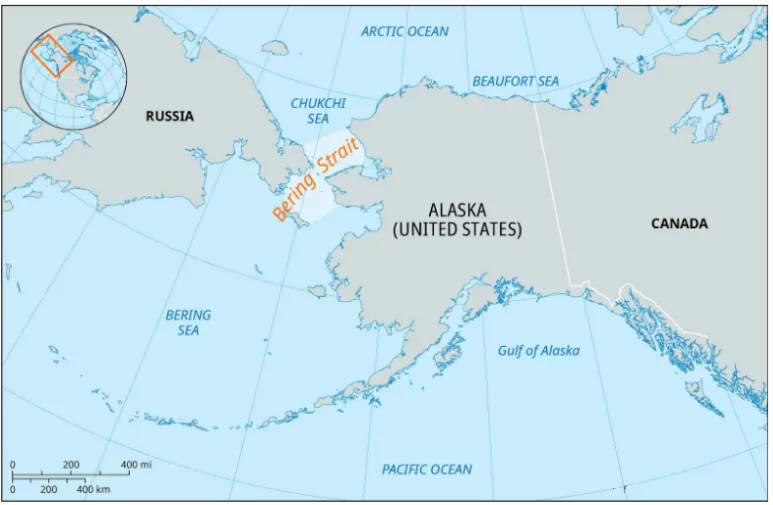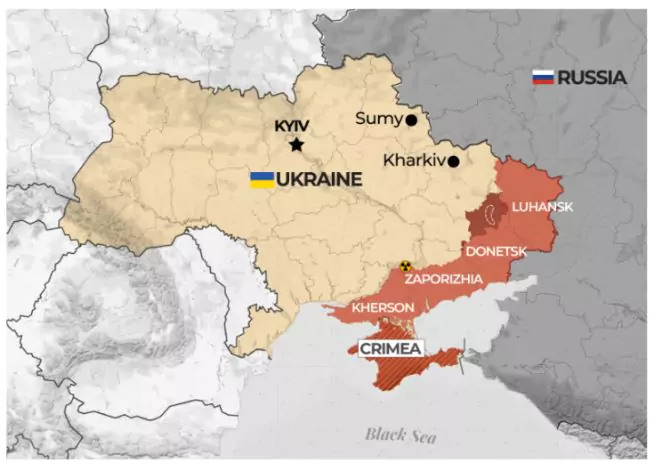Recently, the U.S.– Russia summit was held at Joint Base Elmendorf–Richardson, Anchorage, Alaska between U.S. President Donald Trump and Russian President Vladimir Putin.
About Alaska Summit

- A high-level bilateral summit held at Alaska on 15th August 2025, aimed at addressing global security, economic sanctions, and Arctic regional competition, with ripple effects on India, NATO, and global energy markets.
- Choice of Location (Why Alaska?): Alaska lies across the Bering Strait (~4 km from Russia).
- Historical link: Sold by Russia to the U.S. in 1867 for $7.2 million.
- Symbolic for U.S.–Russia dialogue and relevant to Arctic geopolitics.
- Objectives:
- Explore pathways to peace in the ongoing Russia–Ukraine war (4th year).
- Discuss Arctic resources, shipping lanes, and military competition.
- Address economic sanctions and energy security.
- Propose a future trilateral summit (U.S.–Russia–Ukraine).
About Alaska
- Location: Northwesternmost state of the United States, bordering Canada (Yukon & British Columbia), Arctic Ocean (north), Pacific Ocean (southwest).
- Area: ~1.72 million sq km (largest U.S. state, ~1/5th of the total U.S. area).
- Capital: Juneau (not accessible by road, only by sea/air).
- Major City: Anchorage (~40% of Alaska’s population).
- Population: ~7.4 lakh (2024 est.), lowest population density in the U.S.
- Physical Features: Mountain ranges (Alaska Range, Brooks Range).
- Mount Denali (6,190 m) – highest peak in North America.
- Vast tundra, glaciers, and forests.
- Climate: Arctic in north (very cold, permafrost).
- Subarctic & maritime in south (milder coastal climate).
- Natural Phenomena: Aurora Borealis (Northern Lights) visible in winter.
- Active volcanoes (part of Pacific “Ring of Fire”).
Why Russia Sold Alaska to the U.S. (1867)?
Background
- Alaska under Russian Empire: Russia had claimed Alaska in the 18th century after explorers like Vitus Bering.
- The Russian-American Company managed the fur trade and settlements.
- Population: very sparse (~700 Russians vs. thousands of Indigenous people).
- Alaska Purchase (Treaty of Cession): Negotiated in March 1867, signed by U.S. Secretary of State William H. Seward and Russian envoy Eduard de Stoeckl.
- The U.S. paid $7.2 million (~2 cents an acre).
Key Reasons for Sale
- Financial Troubles of Russia: After the Crimean War (1853–56), Russia was nearly bankrupt.
- Maintaining Alaska was costly with little return.
- Fur trade, once lucrative, was already in decline.
- Geographic Isolation: Alaska was extremely far from the Russian heartland.
- Difficult to supply and defend across the Pacific.
- Fear of Losing Alaska to Britain: Russia feared Britain (its rival in the Pacific and Arctic, especially from Canada) could seize Alaska in a future war.
- Better to sell to the U.S. (friendly power) than risk losing it to Britain for free.
- Low Strategic Value (at the time): In the mid-19th century, Alaska was seen as a “frozen wasteland” with little economic or strategic use.
- Oil, gold, and other minerals had not yet been discovered.
- Strengthening U.S.–Russia Relations: Russia saw the U.S. as a counterbalance against Britain.
- Selling Alaska to the U.S. was a gesture of goodwill to strengthen ties.
U.S. Perspective
- Many Americans mocked the deal, calling it “Seward’s Icebox” or “Seward’s Folly.”
- Seen as a waste of money for barren land.
- However, this perception changed dramatically later:
- Gold discovered (1896, Klondike Gold Rush).
- Oil discovered (20th century, Prudhoe Bay).
- Alaska became strategically vital during WWII and the Cold War.
|
Key Outcomes of the Alaska Summit

- No Immediate Ceasefire; Shift to “Comprehensive Peace Agreement”: The summit did not yield an immediate ceasefire for the Ukraine war. U.S. President Trump reversed his stance, aligning with Putin, by stating the “best way to end the horrific war” is to pursue a comprehensive peace agreement addressing “root causes”.
- Diplomatic Progress: Narrowed gaps between U.S. and Russian positions, with both leaders noting “considerable progress” and agreeing on “many points,” opening a path for future talks.
- Focus on Peace Agreement: Trump shifted to a comprehensive peace deal, aligning with Putin’s stance on addressing “root causes” (territorial control, neutrality), urging Ukraine to negotiate.
- Territorial Sticking Point: Putin proposed freezing southern frontlines (Zaporizhzhia, Kherson) and possibly withdrawing from Kharkiv if Donbas is secured, but Ukraine and Europe rejected concessions.
- Pressure on Ukraine and European Concerns: Trump suggested it was “up to Zelenskyy” to “make a deal” with Russia, implying territorial concessions, a stance Ukraine has consistently rejected.
- European leaders, while not entirely ruling out territorial compromise, insisted on robust security guarantees for Ukraine and the preservation of its freedom to choose security partners.
- Focus on Business & Arctic Cooperation: Putin highlighted the “tremendous potential” for U.S.-Russian investment and business cooperation, including Arctic cooperation, a sentiment echoed by Trump.
- U.S.-Russia and Global Impact: Signaled a potential thaw in relations, with hints of a new arms control pact, though Europe’s reliance on Trump and India’s tariff concerns remain key challenges.
Significance
- Historic U.S.-Russia Engagement: First summit since 2021 and Putin’s first U.S. visit since 2015, marking a rare diplomatic moment.
- Alaska’s Strategic Role: Venue highlighted Arctic geopolitics and historical U.S.-Russia ties, reinforcing Alaska’s global relevance.
- Ukraine War Focus: Emphasized urgency of resolving Europe’s deadliest conflict since WWII, with 19% of Ukraine under Russian control.
- Trump’s Peace Agenda: Aligned with Trump’s campaign promise to end the war, boosting his “deal-maker” image despite no agreement.
- Global Attention: Drew worldwide focus, with implications for NATO, energy markets, and U.S.-China-Russia dynamics.
- Putin’s Diplomatic Coup: Putin’s presence on U.S. soil despite International Criminal Court (ICC) warrant enhanced his international legitimacy.
Geopolitical Implications of the Alaska Summit
For the World
- U.S.-Russia Thaw and Arms Control: The summit indicated a potential reset in U.S.-Russia relations, with Putin hinting at a new arms control pact.
- This could stabilize global nuclear dynamics, though it hinges on Ukraine’s resolution, as noted in the summit’s diplomatic progress.
- Ukraine’s Sovereignty Under Pressure: Trump’s support for Putin’s demands (e.g., territorial concessions, neutrality) risks eroding Ukraine’s sovereignty .
- This could set a precedent for great power influence over smaller states, as per the summit’s focus on battlefield realities.
- European Security Instability: Europe’s dependence on Trump as the sole broker, despite skepticism, weakens its strategic autonomy.
- A U.S. withdrawal could destabilize NATO, with the document highlighting Europe’s limited capacity to replace U.S. support.
- Shift in Global Power Dynamics: The pragmatic peace approach may elevate non-Western powers like China and India as mediators, potentially reshaping global alliances.
- This reflects a move away from traditional Western-led diplomacy.
For India
- Strategic Flexibility Enhanced: A U.S.-Russia détente widens India’s geopolitical space, allowing it to balance relations with both powers.
- India’s welcome of the summit underscores its non-aligned stance and potential mediation role.
- Economic and Trade Challenges: Trump’s threat of 50% tariffs on Indian exports due to Russian oil purchases (effective August 27, 2025, unless deferred) strains India-U.S. trade.
- This necessitates deft diplomacy to protect economic interests.
- Opportunity for Diplomatic Leadership: India’s neutral position and economic stakes position it to mediate, leveraging the summit’s diplomatic opening.
- Opens space for India to act as a potential mediator/bridge in global forums like G20.
- China Factor: A Russia somewhat legitimized by the U.S. may embolden China–Russia axis, adding pressure on India in the Indo-Pacific.
- Economic Room: India can continue its energy trade with Russia without fear of immediate U.S. sanctions escalation.
Challenges of the Alaska Summit
- Lack of Ceasefire Breakthrough: The summit failed to secure an immediate ceasefire, with Trump abandoning his initial push and Putin demanding full Donbas control, including untaken areas, creating a stalemate.
- Territorial Concession Dispute: The primary sticking point remains Putin’s insistence on Ukraine ceding Donbas and other territories, which Ukraine and Europe reject, hindering a workable compromise.
- Exclusion of Ukraine: Ukraine’s absence from initial talks, with decisions potentially imposed by Trump and Putin, undermines Kyiv’s sovereignty and complicates future negotiations.
- European Distrust and Limited Influence: Europe, critical of Trump’s alignment with Putin, lacks veto power over U.S. policy and the capacity to replace U.S. support, forcing reliance on Trump as the sole broker despite skepticism.
- U.S. Disengagement Risk: Trump’s potential withdrawal of U.S. support, resonating with his anti-war MAGA base, could collapse Ukraine’s resistance, creating an imbalance in transatlantic security.
Way Forwards
- Continued Dialogue: Both Trump and Putin indicated a willingness for continued talks, with Trump suggesting “more meetings would follow” and Putin extending a rare invitation for Trump to visit Moscow.
- Zelenskyy’s White House Visit: Ukrainian President Volodymyr Zelenskyy was expected to visit the White House soon after the summit to discuss Putin’s proposals and seek robust security guarantees for Ukraine.
- European Support for Ukraine: European leaders accompanying Zelenskyy to Washington aimed to impress upon Trump the need for Ukraine’s direct involvement in any peace deal and to secure “cast-iron” security guarantees.
- India’s Deft Diplomacy: New Delhi needs to engage in deft diplomacy to navigate the potential economic shock of punitive tariffs from the U.S. while balancing its energy security needs and strategic partnerships.
- Deft diplomacy refers to the skillful, tactful, and strategic conduct of international relations.
- Addressing “Root Causes” and Negotiations: The focus remains on protracted diplomacy to achieve a peace settlement that addresses Russia’s and Ukraine’s future.
- Flexibility in Ukraine and Brussels: Flexibility from Ukraine and European capitals could open the door for a second Trump-Putin summit to formalize new arrangements for Ukraine, although entrenched resistance to compromise could derail the process.
Conclusion
The Alaska Summit 2025 ended without a breakthrough but reshaped geopolitical narratives. It marked Russia’s re-entry into mainstream diplomacy and highlighted the delicate balance of multipolarity. For India, it reinforced the need for strategic autonomy, energy security, and cautious diplomacy in a world where great powers continue to redraw the rules.
![]() 18 Aug 2025
18 Aug 2025



